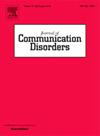The impact of instructions on individual prioritization strategies in a dual-task paradigm for listening effort
IF 2.1
3区 医学
Q2 AUDIOLOGY & SPEECH-LANGUAGE PATHOLOGY
引用次数: 0
Abstract
Introduction
This study examined the impact of instructions on the prioritization strategy employed by individuals during a listening effort dual-task paradigm.
Methods
The dual-task paradigm consisted of a primary speech understanding task in different listening conditions and a secondary visual memory task, both performed separately (baseline) and simultaneously (dual-task). Twenty-three normal-hearing participants (mean age: 36.8 years; 14 females) were directed to prioritize the primary speech understanding task in the dual-task condition, whereas another twenty-three (matched for age, gender, and education level) received no specific instructions regarding task priority. Both groups performed the dual-task paradigm twice (mean interval: 14.8 days). Patterns of dual-task interference were assessed by plotting the dual-task effect of the primary and secondary task against each other. Fisher’s exact tests were used to assess whether there was an association between interference patterns and group (non-prioritizing and prioritizing) across all listening conditions and test sessions.
Results
No statistically significant association was found between the pattern of dual-task interference and the group to which the participants belong for any of the listening conditions and test sessions. Descriptive analysis revealed no consistent strategy use within individuals across listening conditions and test sessions, suggesting a lack of a uniform approach regardless of the given instructions.
Conclusion
Providing prioritization instructions was insufficient to ensure that an individual will mainly focus on the primary task and consistently adhere to this strategy across listening conditions and test sessions. These results raised reservations about the current usage of dual-task paradigms for listening effort.
双任务模式下,听力指导对个人优先级策略的影响
本研究考察了在听力努力双任务范式中,指令对个体优先级策略的影响。方法双任务范式包括不同听力条件下的初级言语理解任务和次级视觉记忆任务,这两个任务分别进行(基线)和同时进行(双任务)。23名听力正常的参与者(平均年龄36.8岁,其中14名女性)被指示在双任务条件下优先处理主要言语理解任务,而另外23名参与者(年龄、性别和教育水平相匹配)没有收到关于任务优先级的具体指示。两组均执行两次双任务范式(平均间隔:14.8天)。通过绘制主次任务的双任务效应来评估双任务干扰模式。Fisher的精确测试被用来评估在所有听力条件和测试过程中,干扰模式和群体(非优先级和优先级)之间是否存在关联。结果双任务干扰模式与被试所属组在任何听力条件和测试环节之间均无统计学意义的关联。描述性分析显示,在不同的听力条件和测试阶段,个体之间没有一致的策略使用,这表明无论给定指示如何,都缺乏统一的方法。提供优先级指导不足以确保个人将主要注意力集中在主要任务上,并在听力条件和测试过程中始终坚持这一策略。这些结果提出了对当前双任务范式用于听力努力的保留意见。
本文章由计算机程序翻译,如有差异,请以英文原文为准。
求助全文
约1分钟内获得全文
求助全文
来源期刊

Journal of Communication Disorders
AUDIOLOGY & SPEECH-LANGUAGE PATHOLOGY-REHABILITATION
CiteScore
3.30
自引率
5.90%
发文量
71
审稿时长
>12 weeks
期刊介绍:
The Journal of Communication Disorders publishes original articles on topics related to disorders of speech, language and hearing. Authors are encouraged to submit reports of experimental or descriptive investigations (research articles), review articles, tutorials or discussion papers, or letters to the editor ("short communications"). Please note that we do not accept case studies unless they conform to the principles of single-subject experimental design. Special issues are published periodically on timely and clinically relevant topics.
 求助内容:
求助内容: 应助结果提醒方式:
应助结果提醒方式:


